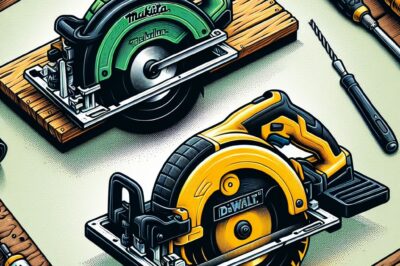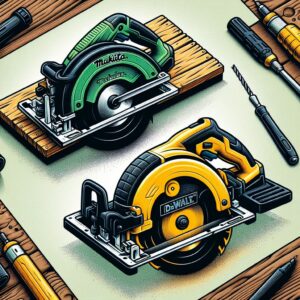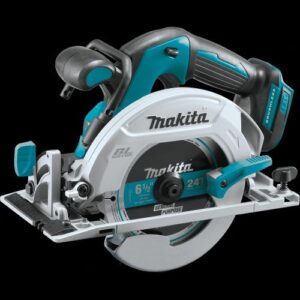
Key Takeaways
Practical tips for reducing noise levels and maintaining a quieter work environment.
Makita and DeWalt circular saws both have unique noise profiles, which can impact user comfort.
The decibel level, or dB rating, is crucial for comparing the loudness of different saws.
Various factors, including saw design and blade type, can influence the noise a circular saw makes.
Understanding and comparing the noise levels of these saws can lead to a more informed choice for DIY enthusiasts.
Quieting the Cut: Noise Reduction Tips
Use sharp blades to reduce the workload on the saw and minimize noise.
Opt for blades with fewer teeth for rough cuts to keep the noise down.
Ensure the saw’s base plate is firmly attached to reduce vibrations.
Perform regular maintenance on your saw to keep it running smoothly and quietly.
Consider using noise-dampening accessories like anti-vibration gloves.
The Quest for Quiet: Understanding Circular Saw Noise
When you’re in the middle of a project, cutting through wood like a hot knife through butter, the last thing you want is to feel like you’re at the front row of a rock concert—without the fun. Circular saws are powerhouses, but with great power comes great… noise. It’s not just about keeping your ears happy; prolonged exposure to loud noise can lead to hearing damage. So, let’s dive into what makes these tools roar and how to compare their sound levels. Most importantly, we’ll look at two popular brands, Makita and DeWalt, to see which one lets you keep your peace of mind while you work.
Sawing Through the Specs: Makita Sound Output
Makita circular saws are known for their quality and durability, but how do they fare in the noise department? Typically, the noise level of a circular saw is measured in decibels (dB). The higher the dB, the louder the saw. Makita saws usually come with a noise rating on their spec sheets, which gives us a ballpark figure to start with. However, remember that these numbers can change depending on how you use the saw. We’ll get into the nitty-gritty of that later.
Listening to the Evidence: DeWalt Sound Signature
On the flip side, DeWalt circular saws also boast robust construction and precision. But if we’re talking about noise, DeWalt has its own sound signature. Some users say DeWalt saws have a more ‘bearable’ pitch even if the dB levels are similar to other brands. This could be due to the design of the motor or the materials used in construction. Again, there’s more to these numbers than meets the eye, and we’ll explore that in depth.
Comparing Decibels: A Side-by-Side Look
Now, let’s lay it out straight: comparing Makita and DeWalt saws isn’t just about throwing dB numbers around. It’s about understanding those numbers in the context of real-life use. That’s why we’ll compare these brands under similar conditions to see which one truly offers a quieter cutting experience. Because at the end of the day, we all want a saw that does the job without making our ears ring.
Breakdown of DeWalt Saw Noise Levels
DeWalt’s range of circular saws, much like Makita’s, come with their own set of noise level specs. Typically, these noise levels are provided in decibels (dB) and can vary depending on the model and blade speed. Some DeWalt saws have lower dB ratings, which indicates a quieter operation. But, it’s not just about the numbers; the quality of sound matters too. DeWalt’s engineering often focuses on minimizing vibration, which can reduce the harshness of the noise.
Real-World Sound Tests: DeWalt at Work
To truly understand how loud a DeWalt circular saw is, you’ve got to hear it in action. In a controlled environment, with the saw cutting through standard 2×4 lumber, DeWalt saws can produce noise levels that might surprise you. Some users report that even with a high dB rating, the saw’s noise can be less grating to the ears compared to other brands. For a closer look at handling DeWalt tools in compact spaces, check out power tool tips for small space woodworking.
For example, the DeWalt DWE575SB, a popular model, has a no-load noise level of around 85 dB. But when it’s ripping through wood, the sound level can jump up, so always wear ear protection.
Real-world tests often reveal that under load, the saw’s noise can increase significantly, which is why it’s important to consider the type of work you’ll be doing and the duration of use when comparing saws.
The Role of Blades and Materials in DeWalt Saw Noise
It’s not just the saw that affects the noise—it’s also the blade and the material you’re cutting. A dull blade can cause the saw to work harder, increasing the noise level. Likewise, cutting through harder materials can cause more noise than softer materials. DeWalt’s saws are designed to accommodate a variety of blades, which means you can choose a blade that not only cuts efficiently but also operates quieter.
Head-to-Head: Noise Level Comparison
Comparing Makita and DeWalt side by side in terms of noise is where we really start to see differences. By setting up both saws in similar conditions and using the same type of blade and material, we can get a direct comparison of the noise output. This is where the rubber meets the road, and you can decide which saw’s noise level is more tolerable for your workspace.
Direct Noise Comparison Under Similar Conditions
Imagine both saws, a Makita and a DeWalt, lined up in your workshop, each with a fresh blade and a piece of pine to cut through. You fire them up and push them through the wood. You might find that while the dB levels are close, the sound quality is different. One might have a higher-pitched whine while the other has a lower rumble. This can make a big difference in how you perceive the noise, especially over time.
Impact of Saw Design on User Comfort
The design of the saw impacts not just performance but also how noise is generated and transmitted. Features like rubberized handles and stable base plates can dampen vibration, making the saw feel quieter. Both Makita and DeWalt pay attention to these details, but you’ll want to handle each saw to get a feel for which one’s noise level is more comfortable for you.
Looking Beyond the Loudness: Performance vs. Peace
While noise levels are important, they aren’t the only factor to consider when choosing a circular saw. You’ll also want to think about performance, ease of use, battery life (for cordless models), and how the saw feels in your hands. Sometimes, a slightly louder saw might be worth it if it cuts better and makes your work easier.
Effective Usage Techniques for Lower Noise
Your technique can also play a role in how much noise your saw generates. For instance, pushing the saw too fast can create more noise, as can forcing it through the material. Let the saw do the work at a steady pace, and you’ll find it runs a bit quieter.
Feed the saw smoothly and steadily to prevent noise spikes.
Support your workpiece properly to avoid chatter and excess noise.
Use the correct saw speed for the material you’re cutting to reduce noise.
Selection of Blades and Accessories for Reduced Sound
The blade you choose can have a big impact on noise levels. A blade designed for quiet operation can make a noticeable difference. Look for blades with laser-cut stabilizer vents, which can reduce noise and vibration. Also, consider the tooth count; fewer teeth can mean less noise for rough cuts, while more teeth are better for fine, quiet cuts.
Maintenance Tips to Keep the Decibels Down
Keeping your circular saw in tip-top shape is not just about performance; it’s about maintaining a more peaceful work environment. Regular maintenance can prevent unnecessary noise caused by wear and tear. For instance, ensure that all bolts and screws are tight to avoid rattling, and lubricate moving parts to keep them running smoothly. A well-maintained saw is a quieter saw.
It’s also wise to check for any build-up of sawdust or debris that can cause the motor to work harder, thus creating more noise. Clean your saw after each use, and give it a more thorough cleaning and inspection regularly. Remember, a clean saw is not just a happy saw; it’s a quiet one.
Final Verdict: Which Saw Sounds Off Less?
After comparing Makita and DeWalt circular saws, it’s clear that both brands have their merits in terms of noise levels. Makita saws tend to have a reputation for lower decibel ratings on paper, which suggests a quieter operation. However, DeWalt saws often have a sound quality that many users find less irritating, despite similar dB levels.
The design and engineering of both brands aim to reduce noise, but the experience can be subjective. Some users might prefer the sound profile of Makita, while others might lean towards DeWalt. The choice often comes down to personal preference and the specific model of the saw.
In the end, when considering noise levels, the best approach is to test the saws yourself if possible. Pay attention to the dB ratings, but also to how the saw sounds to you personally. And don’t forget to factor in other important features like performance and comfort.
Your Best Bet for a Quieter Work Environment
For a quieter work environment, your best bet is to consider a combination of the saw’s design, your usage technique, and the type of blade you use. Opt for a saw that has a good balance between performance and noise level. Use sharp blades and the right cutting speed to minimize strain on the saw, and always maintain your saw well. Lastly, don’t overlook the value of ear protection to safeguard your hearing.
Frequently Asked Questions (FAQ)
Many of you have questions about circular saws and noise levels. Let’s tackle some of the most common queries.
What is the average noise level for a circular saw?
The average noise level for a circular saw can range between 90 to 100 decibels (dB). To put that into perspective, that’s about as loud as a motorcycle. It’s important to note that sustained exposure to noise above 85 dB can cause hearing loss over time, which is why ear protection is crucial.
Can the type of material being cut affect the saw’s noise level?
Absolutely, the material you’re cutting can impact the noise level of your circular saw. Cutting through harder materials like hardwood or metal can cause the saw to emit more noise compared to softer materials like pine or MDF (Medium Density Fiberboard). It’s all about how much resistance the saw meets during the cut.
Here’s a simple example: imagine cutting through a piece of soft pine versus a dense oak. The oak is going to make your saw work harder, which will typically result in more noise.
For instance, cutting through plywood might produce around 90 dB of noise, while cutting through a denser material like oak might bump that up to around 100 dB.
Therefore, it’s important to consider the type of projects you’ll be undertaking and the materials you’ll be using when selecting a circular saw.
Are there any ear protection recommendations when using these saws?
Yes, ear protection is highly recommended when using circular saws. Options include foam earplugs, which are disposable and easy to use, or earmuffs that provide a higher level of noise reduction. For the best protection, especially during prolonged use, consider earmuffs with a high Noise Reduction Rating (NRR).
How often should I perform maintenance to reduce noise output?
Performing maintenance on your circular saw should be a regular part of your routine. A quick clean after each use and a more thorough check-up every few months is a good rule of thumb. This includes tightening any loose parts, lubricating moving components, and checking the blade for wear and tear.
If you notice an increase in noise or a change in the sound of your saw, it’s a good indicator that maintenance is due. Keeping up with these simple practices can extend the life of your saw and keep it running quieter for longer.
Does the blade size of a circular saw impact its noise level?
The size of the blade can influence the noise level, but perhaps not as much as you might think. Larger blades have to move more air and can create more noise as a result, but the difference is often marginal. What’s more impactful is the condition of the blade and the number of teeth. A dull blade or one with the wrong tooth count for the job can significantly increase noise levels.
For example, a 7-1/4 inch blade is standard for many circular saws and will generally offer a balance between cutting ability and noise level. However, if that blade is dull or has too many teeth for the material you’re cutting, you’ll notice an uptick in noise.




Leave a Reply